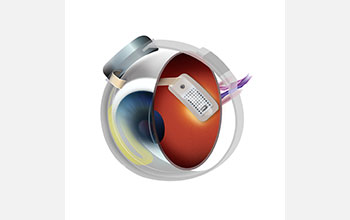Multimedia Gallery
Argus II Retinal Prosthesis System
Devices that tap directly into the nervous system--called brain-machine interfaces, or BMIs--can restore sensation, movement or cognitive function. The Argus II® Retinal Prosthesis System works by bypassing damaged photoreceptors, cells in the retina that normally convert light into electrical signals that the brain interprets as visual information, then transmitting images from a small camera to an implant in the back of the eye. Like the photoreceptors, the implant produces electrical signals that are transmitted to the brain.
In 2013, the U.S. Food and Drug Administration approved Argus II for use in individuals who have lost their vision as a result of severe to profound retinitis pigmentosa. A genetic condition affecting one in every 4,000 individuals, early symptoms of retinitis pigmentosa often include night blindness followed by gradual but progressive loss of peripheral vision and ultimately total blindness.
Development of Argus II was supported in part by grants from the National Science Foundation (grants CBET 03-35836, CBET 98-10914, ECCS 03-00181). To learn more, see the NSF Discovery story How to build a brain-machine interface. Also, see NSF press release Artificial Retina Receives FDA Approval. (Date of Image: 2013)
Credit: Second Sight Medical Products
Images and other media in the National Science Foundation Multimedia Gallery are available for use in print and electronic material by NSF employees, members of the media, university staff, teachers and the general public. All media in the gallery are intended for personal, educational and nonprofit/non-commercial use only.
Images credited to the National Science Foundation, a federal agency, are in the public domain. The images were created by employees of the United States Government as part of their official duties or prepared by contractors as "works for hire" for NSF. You may freely use NSF-credited images and, at your discretion, credit NSF with a "Courtesy: National Science Foundation" notation.
Additional information about general usage can be found in Conditions.
Also Available:
Download the high-resolution JPG version of the image. (681 KB)
Use your mouse to right-click (Mac users may need to Ctrl-click) the link above and choose the option that will save the file or target to your computer.



